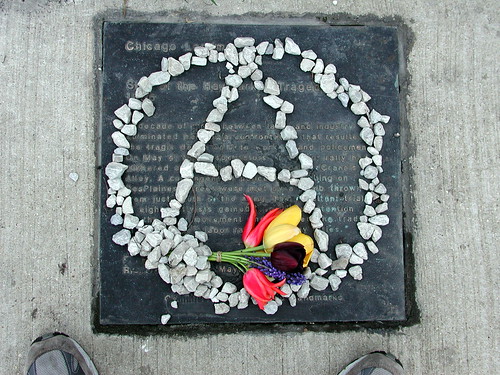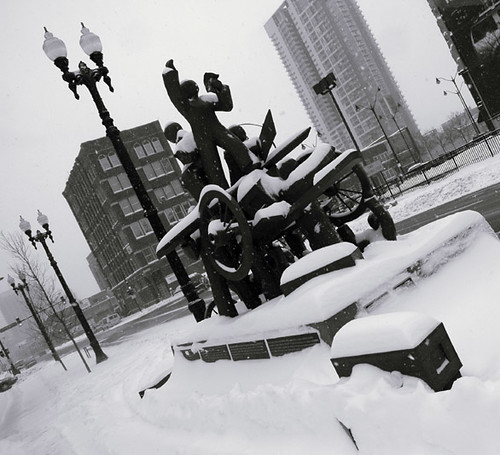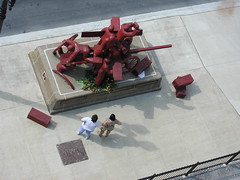
Haymarket Riot memorial plaque, after the statue of the Chicago Police was taken down, but before Mary Brogger's new statue was installed.

new Haymarket Riot memorial (abstracted figures only)

Death in the Haymarket looks like a quite interesting book. Then again, I've adopted the Haymarket seeing as I live/work so close to it. Note to potential stalkers - there are plenty of dwellings within a block radius, so don't get your hopes up.
The New Yorker: THE TERROR LAST TIME by CALEB CRAINOn May 4, 1886, several anarchists had addressed a crowd in the Haymarket, a square in Chicago two blocks long where farmers sold produce. When nearly a hundred and eighty policemen arrived to break up the rally, someone threw a bomb, and the police opened fire. At least seven patrolmen died, and at least four civilians. Over the next few weeks, the authorities rounded up and detained hundreds of the city’s anarchists. Eight men were put on trial for murder, the most prominent of whom were Albert Parsons and August Spies (pronounced “Spees”). Parsons led the city’s English-speaking anarchists, and Spies the German-speaking ones. Aside from Parsons and a teamster named Samuel Fielden, the defendants were of German ethnicity: Michael Schwab had assisted Spies in editing the movement’s German-language newspapers; George Engel and Adolph Fischer had belonged to a militant cell; Louis Lingg, a wild young man, had dabbled in bomb-making; and Oscar Neebe, a yeast-maker, had served on a few anarchist committees.
The prosecution never proved that any of the eight had planned, committed, or even known in advance about the Haymarket bombing. Instead, it relied on their words. All of them had praised violence in the cause of socioeconomic justice. “If we would achieve our liberation,” Parsons had told a crowd of protesters in April of 1885, “every man must lay by a part of his wages, buy a Colt’s navy revolver, a Winchester rifle, and learn how to make and use dynamite.” The prosecution argued that anarchism itself constituted a conspiracy to commit murder, and the jurors agreed, sentencing all but one of the defendants to death. The person who actually threw the bomb was never identified.
William Morris, Oscar Wilde, George Bernard Shaw, and Friedrich Engels signed petitions on behalf of the condemned, but Howells was virtually the only American writer to do so. “For many weeks, for months, it has not been for one hour out of my waking thoughts,” he wrote. “It blackens my life.” The newspapers mocked him for caring—over one of his heartfelt letters, the Chicago Tribune printed the snide headline “MR. HOWELLS IS DISTRESSED”—and called the anarchists Europe’s “scum and offal”; they were hyenas, wolves, vipers, savages, cutthroats, and fiends. One student of the Haymarket affair has called it “the first major ‘red-scare’ in American history.”
article continues here

Haymarket Riot Memorial another view.
(clicking photos makes 'em embiggen).
(oh, and thanks to CorrenteWire for the reference, such that it was. I hadn't gotten my New Yorker yet.)
